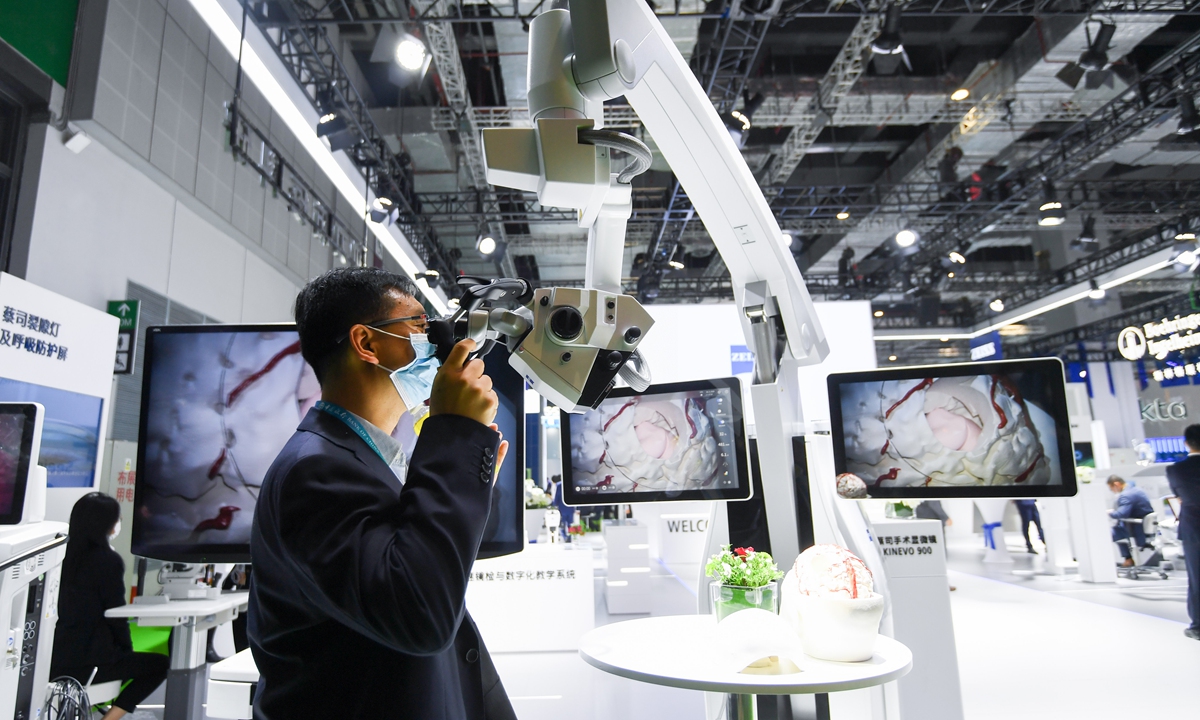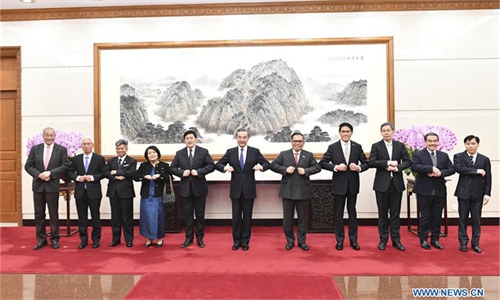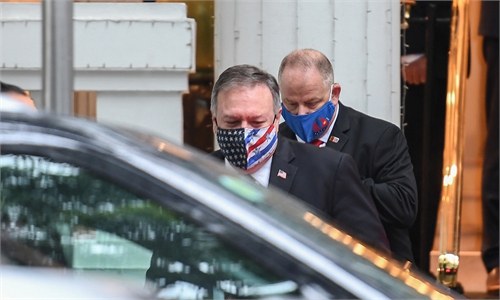Economic freedom: Xi leading other Chinese leaders at the fifth plenary session of the 19th Central Committee of the CPC in Beijing on Oct 29. China’s leaders are vowing to make their country a self-reliant “technology power” after a meeting to draft a development blueprint for the state-dominated economy over the next five years. — Xinhua via AP
WHILE the world was following the US presidential elections closely hoping for a positive change in international dynamics, they did not ignore the most important political meeting taking place in China on Oct 26-29.
The developments in China – the only country showing solid economic recovery after combating the Covid-19 epidemic in Wuhan – are too important to be eclipsed by the drama in Washington led by President Donald Trump.
The Oct 26-29 meeting gave a glimpse of the future plans of China, after Beijing withstood two major challenges: the containment from the US and a major public health crisis caused by the novel coronavirus.
The effective control of the virus has enabled China to revitalise its economy, which it contracted in the first half of the year. In the third quarter, China’s GDP posted a positive growth and is expected to see even stronger expansion this quarter.
It is against this backdrop that China was holding its most important policy meeting this year.
Over the four days, top leaders of the Communist Party of China (CPC) led by President Xi Jinping deliberated China’s 14th Five-Year Plan (2021-2025) to chart the future development path for the world’s second largest economy.
They also endorsed a blueprint to achieve President Xi’s vision of turning China into a “great modern socialist nation” by 2035, which by then is expected to be “prosperous, strong, democratic, culturally advanced and harmonious”.
The Fifth Plenary Session of the 19th CPC Central Committee set goals to spur China’s modernisation drive, pursue self-reliance in science and technology to support its development and modernise defense capabilities, according to a post-plenum press conference live on CCTV4.
A communique summarizing the decisions was released on Oct 29 night to the media.
More than 200 leaders and elite members of CPC met behind closed doors to identify policy priorities for keeping the economy growing in the middle of a pandemic, supply chain disruptions, toxic relations with the West and global economic downturn, according to the South China Morning Post.“This five year plan is China’s most important policy program, which sets goals and directions for the national economic and social development, ” said Professor Wang Wen, who was involved in drafting the plan.
The executive dean of Chongyang Institute for Financial Studies at Renmin University of China added that this plan is a “very comprehensive plan” as public opinion was collected on the Internet and reported to decision-making levels.
And President Xi had personally held frequent symposiums on various fields and sectors ahead of the plenary session.
“The plan takes into account the interests and demands of the whole country, various industries, regions and institutions. It is a design to start a new journey of fully building a modern socialist country after China completes the building of a moderately prosperous society in all respects, ” Wang said in a post-event comment piece emailed to Sunday Star.
At the post-event press conference on Oct 30, the media were told Beijing would actively promote “technological self-reliance” to speed up China’s ambition as a “technology power.”
Self-reliance is the main theme of the five-year plan as China faces the threats of economic decoupling and de-globalisation, as well as other headwinds, the media learnt.
China had to nurture its own microchip producers and high technology in the face of US export curbs that has hurt China’s tech industry.
According to a report, Chinese telecommunications giant Huawei has lost a lot of its supply sources of high-precision chips; and if the US ban continues and Beijing does not act, Huawei may have to stop its high-end smart-phone production.
“We will take scientific and technological self-reliance as a strategic support for national development, ” Han Wenxiu, an adviser to President Xi, said at the Oct 30 news conference.
State-linked Global Times, in its editorial, said Trump’s China policies have awakened the Chinese from complacency.
It said: “If it were not for the US’ suppression, Chinese people may have always built our industries on American semiconductors.
“Over the past four years, the US’ China policy has awakened China. It has made us understand we may be stuck on key technologies and we must make up for technological shortcomings.
“It has also convinced us that the US will not accept China’s rise and will do everything to suppress China. This is a cold reality.”
The CPC plenary session has also endorsed the “dual circulation” economic strategy.
Under this new strategy, China will remain open to foreign investment and trade, while moving its pivot to build up an internal economy. The model looks at the domestic market as the country’s economic mainstay, with domestic and foreign markets complementing each other.
Although there is greater emphasis to create the domestic economy by spurring local spending, China will continue to open more sectors to foreign investors.
The message sent to foreigners is: China will not isolate itself from the global economy while developing its domestic economy to be self-reliant in all aspects.
And in fact, at the opening of Shanghai’s third import expo on Wednesday, Xi announced China wants to import more and be the market of the world. He added China’s 400 million-strong middle class will be ready consumers.
According to Han, the Oct 26-29 meeting also decided that China will continue to pursue reforms and open up as it believes in multilateralism and globalisation.
He said: “We will never waver in our national policy of opening up. China will provide countries around the world with larger markets and more opportunities.”
In the next five years, China will focus on high-quality growth and expansion of domestic markets, as well as increasing its innovation capability.
“As China is no longer a follower but a front-runner, the meeting must have considered how China can lead the global economy. The following five years will not be easy. However, as long as we grasp the law, enhance awareness of risks and opportunities... China
will witness a completely new scene of development, ” commented Wang.
As China is facing possible risks of clashes with the US and its allies that are conducting extensive military exercises in waters in South China Sea and nearby waters, military buildup is on the agenda in the next five years.
“China’s necessary military buildup is urgent. Based on the principle of effective defense, besides establishing military advantages in coastal waters, we must consolidate our strategic deterrence based on nuclear capabilities, ” explained Global Times in its editorial.
“We must make Washington realise that it is facing a China that it should be wary of trifling with, and that treating China as a friend rather than a foe much better fits US national interests, ” added Global Times.
Despite this, the communiqué released said the party plans to promote peaceful reunification of Taiwan.
In the four-day intense meeting, the welfare and interests of the people were not left out.
After eradicating the last of extreme poverty this year and lifting 700 million out of abject poverty in the past 40 years, the next goal for the CPC leaders is to hit its target of building a “moderately prosperous society” in 2021.
In fact, the goal to become “a moderately prosperous society” in by 2021 has been achieved, according to state media.
Acknowledging that the Covid-19 pandemic has affected many people, the plenary session discussed employment, income disparity, the quality of life and education, health issues and elderly care, the media were told on Oct 30. While the plenary session deliberated a lot on economic issues, foreign media are keen to scrutinise it from a political angle. To Japan’s Nikkei, the “2035”
figure is a magical figure that could provide indication on the leadership tenure of Xi, who became president in 2013.
“The long-running speculation that Xi is considering staying in power way past 2022 was in effect confirmed as China put in motion an ultralong 15-year vision promising new levels of prosperity by 2035, ” reported Nikkei.
But whether outsiders love CPC or not, China’s 1.4 billion Chinese have the final say.
According to a nationwide survey, about 95% of Chinese nationals polled said they support the CPC leaders and are satisfied with the manner they govern the country and overcome the Covid-19 crisis.
“History has selected the CPC to lead China and its people. The CPC, under the strong and excellent leadership of President Xi, will continue to rule China, ” declared one of four spokesmen at the Oct 30 live press conference.
He added: “The plenary session believes that under the leadership of Xi Jinping, China will be able to face risks and tackle challenges ahead and advance a socialist economy with Chinese characteristics.”
Related posts:
China 13th Five-Year Plan 2016-20 Summary, sets ‘pragmatic’ targets through 2035
During the 13th Five-Year Plan period, from 2016 to 2020, China has made great strides in improving the economy, people's livelihood and other fields. China has contributed over 30 percent to global economic growth, with GDP hitting almost 100 trillion yuan ($14.9 trillion). Over 50 million people have been relieved from poverty, and 53.78 million new urban jobs have been created. New standard bearers in technology emerged, including high-speed trains, the BeiDou Navigation Satellite System and domestic passenger aircraft C919. This rapid technological development can be attributed to investment in research and development, which totaled 2.17 trillion yuan in 2019, accounting for 2.19 percent of GDP and up 56.3 percent from 2015.
Related:






No comments:
Post a Comment